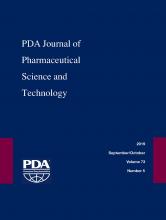Abstract
In the vapor-phase hydrogen peroxide (VPHP)-sanitized environment, VPHP uptake by product-contacting components could eventually lead to undesired oxidation of biological drug products. Silicone tubing and primary packaging materials are prominent examples of such product-contacting surfaces that are typically processed/sterilized prior to use. This study investigated the VPHP-uptake tendency of these components and how their respective processing/sterilization methods affect the uptake behaviors. Silicone tubing that was sterilized via autoclave or gamma irradiation exhibited different VPHP uptake patterns—decreased uptake rates post autoclaving vs. increased uptake rates post gamma irradiation. The reduced uptake tendency of autoclaved tubing is maintained for 14 days after sterilization, whereas the uptake tendency of irradiated tubing was mostly reversed to normal levels 1 month after irradiation. Empty glass vials adsorbed hydrogen peroxide via the diffusion of VPHP into the vial with high vial-to-vial variability. Vial pretreatment (i.e., depyrogenation) and surface hydrophilicity/hydrophobicity impacted the uptake tendency. Stoppers and empty syringes also adsorbed hydrogen peroxide but at a relatively low level. The uptake behavior of these components appeared to correlate with water levels at the surface (i.e., hydrophilicity). This study provides process development scientists and engineers an in-depth understanding of the VPHP uptake by critical product-contacting surfaces so that they can mitigate the impact on drug product quality.
LAY ABSTRACT: This study investigated vapor-phase hydrogen peroxide (VPHP) absorption by biopharmaceutical drug products via VPHP uptake by critical product-contacting components during the aseptic manufacturing process with a focus on various pretreatments and processing of these components. Sterilization of silicone tubing by gamma irradiation or autoclaving resulted in different VPHP uptake profiles with different effect durations. Primary packaging components, such as vials, syringes, and stoppers, also showed different levels of VPHP uptake with surface hydrophilicity/hydrophobicity playing a critical role. These outcomes suggested that VPHP uptake is a complex phenomenon and should be carefully considered to minimize its impact on product quality. The approach and outcome of this study can benefit scientists and engineers who develop biological product manufacturing processes by providing an in-depth understanding of drug product process risks.
- Vapor-phase hydrogen peroxide
- Monoclonal antibody
- VPHP uptake
- Primary packaging components
- Silicone tubing
- Sterilization
- Gamma irradiation
- Autoclave
- VHP
- Vaporized hydrogen peroxide
- © PDA, Inc. 2019
PDA members receive access to all articles published in the current year and previous volume year. Institutional subscribers received access to all content. Log in below to receive access to this article if you are either of these.
If you are neither or you are a PDA member trying to access an article outside of your membership license, then you must purchase access to this article (below). If you do not have a username or password for JPST, you will be required to create an account prior to purchasing.
Full issue PDFs are for PDA members only.
Note to pda.org users
The PDA and PDA bookstore websites (www.pda.org and www.pda.org/bookstore) are separate websites from the PDA JPST website. When you first join PDA, your initial UserID and Password are sent to HighWirePress to create your PDA JPST account. Subsequent UserrID and Password changes required at the PDA websites will not pass on to PDA JPST and vice versa. If you forget your PDA JPST UserID and/or Password, you can request help to retrieve UserID and reset Password below.






